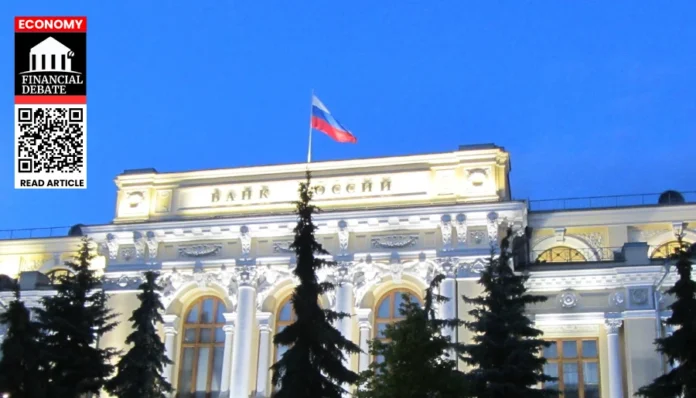- Russia made its biggest interest rate cut in 3 years, reducing the rate by 2%.
- Slowing inflation and weak economic growth pushed the central bank to act.
- The government now faces a tough balance between supporting growth and controlling inflation.
Russia’s Central Bank Makes Bold Rate Cut
Russia’s central bank has taken a major step to support the economy. On Friday, it lowered the main interest rate from 20% to 18%. This 2% cut is the biggest in three years. The move shows Russia is now shifting away from the strict wartime economic rules.
Earlier in June, the bank already cut the rate by 1%. That marked the beginning of a new trend. Officials believe the war-time emergency measures are no longer needed at the same level.
Why the Rate Was Cut
Inflation in Russia is finally slowing. In June, inflation was 9.4%, slightly better than May’s 9.9%. This is the lowest level in seven months. A stronger ruble and lower spending by people helped reduce price increases.
Experts say inflation for the second quarter was around 4.8% when adjusted for seasons. This is almost half the speed seen earlier in the year.
But while prices rise slower, the economy also grows slower. In the first three months of 2025, Russia’s economy only grew by 1.4% compared to last year. This is the slowest growth since 2023. The central bank admitted that people are spending less, and the economy is cooling down.
Pressure from Business Groups
Big Russian companies have been asking for lower interest rates for months. They said the high rate of 20% made it hard to borrow money and invest in new projects.
Even Russia’s Economy Minister Maksim Reshetnikov publicly asked for a rate cut. He wants the country to grow at least 3% each year, as promised by President Vladimir Putin. The latest decision shows the bank is listening to this pressure.
Still, the central bank governor, Elvira Nabiullina, insists the policy is still strict. They are careful not to ease too much too fast.
Experts See a Mixed Message
Sofia Donets, the chief economist at Tinkoff Bank, called the bank’s message “hawkish”—meaning cautious—even though they cut rates. She said the central bank still expects the average rate this year to be between 18.8% and 19.6%. The rate may only drop to 12% by 2026.
The bank hopes inflation will go down to 6–7% by December. By 2026, they aim to bring it back to 4%, which is their main goal. But this depends on no new problems like energy shocks or a weaker ruble.
What the Markets Think
Investors did not panic after the announcement. The Moscow Exchange fell slightly by 0.2%. The ruble remained stable around 79 per U.S. dollar.
The central bank’s next meeting is on September 12. Many expect more rate cuts in the coming months. Bloomberg’s survey showed most economists think the rate could fall to 16–17% by the end of 2025. Some even believe it may drop to 15%.
Balancing Act Ahead
Russia’s central bank faces a big challenge. They want to support companies and families by lowering borrowing costs. But they must also avoid making inflation worse.
A financial expert in Moscow said, “The risk of recession is serious now—but inflation is still a big threat.”
This means the central bank must walk a fine line. If they cut too fast, inflation could rise again. If they don’t cut enough, businesses might struggle more.
Article Link: Canada’s Economy: Inflation Slows Down, But Core Prices Paint a Different Picture
Slowing Growth in 2025
Russia’s economy grew well in 2024. The country reported a strong 4.1% growth rate, helped by government spending. But 2025 started badly.
In the first quarter, growth dropped to just 1.4%. Compared to the last quarter of 2024, this is a 0.6% fall. That makes it Russia’s first quarterly decline since 2022.
Some sectors are shrinking. Mining, trade, real estate, and tourism are all doing worse. Only manufacturing and public jobs showed any growth.
Why the Economy Is Slowing
Three main reasons explain the slowdown:
- War Spending Has Peaked
Russia has already built many of the factories it needs for military supplies. Government spending can’t grow much more. - Labor Shortages
The army is still taking many young workers. This makes it hard for companies to hire staff. Unemployment is just 2.3%, a historic low, but it’s hurting productivity. - High Borrowing Costs
To fight inflation, the bank raised interest rates to 21% in 2024. This made loans expensive. As a result, people and businesses have stopped borrowing.
What the Future Looks Like
Most forecasts now suggest Russia’s economy will grow only 1.5% to 2.5% in 2025. The International Monetary Fund and Russia’s own central bank are less hopeful—they expect growth closer to 1.5%.
The main worry is whether Russia can keep its economy growing without more government help. Private businesses are cautious, and people are spending less.
The strong growth from 2024 may not return soon.
Article Link: Developing Countries Face Unprecedented Debt Repayments to China in 2025 Amid Belt and Road Legacy
Final Thoughts
Russia is trying to fix a slowing economy while managing high inflation and war costs. Lowering interest rates may help, but it’s a risky move. Too much easing could cause prices to rise again. Too little might slow the economy even more.
The next few months will show if the central bank can find the right balance. Everyone is watching closely, especially ahead of the September meeting.
